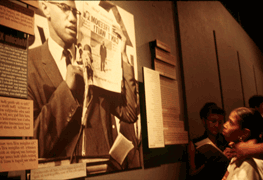1966: the Black Power phase of the struggle
 By 1965, many activists were beginning to pay heed to Malcolm X's call for self-defense, and were prepared to turn away from nonviolent direct action. They began to think that it wasn't enough to take down the "whites only" signs. It wasn't enough just to "dream" about an integrated, color-blind society. No sooner had the Voting Rights Act been signed into law, than an era was born which shared Malcolm X's impatience with the slow pace of change and the violence aimed at Black people. The August 1965 uprising in the Watts area of
By 1965, many activists were beginning to pay heed to Malcolm X's call for self-defense, and were prepared to turn away from nonviolent direct action. They began to think that it wasn't enough to take down the "whites only" signs. It wasn't enough just to "dream" about an integrated, color-blind society. No sooner had the Voting Rights Act been signed into law, than an era was born which shared Malcolm X's impatience with the slow pace of change and the violence aimed at Black people. The August 1965 uprising in the Watts area of
Meanwhile, the concept of "Black Power," a phrase used by Richard Wright as the title for a book, and by the activist, singer and actor Paul Robeson in the 1950s, was being discussed in SNCC offices. It would first capture national media attention at a
SNCC tried to use the new Voting Rights Act to bring democracy and Black political power to
The Black Panther symbol would soon be adopted by the Black Panther Party for Self-Defense in
Looking back, SNCC veteran James Forman, who briefly was a member of the Black Panther Party, described the transformation of the Movement in these terms:
"Voting discrimination and segregation of public facilities had generally disappeared after years of protest -- that protest which produced the 1964 Civil Rights Act and the 1965 Voting Rights Act. At the same time, the newly established political rights of black people in the South were being undermined by whites in many ways: deliberate miscounting of votes, bribery, economic intimidation of voters. The South was becoming more and more like the North. The fundamentals of racism – inadequate housing, lack of jobs, insufficient medical attention, inferior education – remained basically unchanged throughout black communities, whether in
"Black Power" meant a new emphasis on self-defense, racial pride, African heritage, and grassroots organizing for Black cultural and economic advancement. Many civil rights activists thought it took the struggle to a higher level, and ensured some concrete gains for Black people.
1967: the cities burn
In the summer of 1967, as calls for "Black Power" came to national attention, there were uprisings similar to the 1965 Watts rebellion in cities across the country. In
Horrified by the violence, Dr. King was determined to demonstrate that nonviolent methods could be used effectively in the fight for political power and economic justice. In the last year of his life he told the US Senate that "the great challenge facing the civil rights movement is to organize and gain identity with ghetto dwellers."
To focus the nation's attention on economic inequality, Dr. King planned to mobilize African Americans, poor whites, Hispanics, and Native Americans in a "Poor People's Campaign." He wanted to bring them to
Meanwhile, King was angering those in power by condemning the Vietnam War. Instead of using resources to fight poverty at home, he declared, the
"It became clear to me that the war was doing far more than devastating the hopes of the poor at home. It was sending their sons and their brothers and their husbands to fight and to die in extraordinarily high proportions relative to the rest of the population....So we have repeatedly been faced with the cruel irony of watching negro and white boys on TV screens as they kill and die together for a nation that has been unable to seat them together in the same schools. So we watch them in brutal solidarity burning the huts of a poor village, but we realize that they would never live on the same block in
The struggle for economic equality took Dr. King to
In the wake of his death, more than a hundred cities went up in flames. The nation's television screens were dominated by images of the National Guard and army in full battle gear patrolling our own burning streets, while other
The Kerner Commission report on the 1967 burning of cities was published a month before Dr. King's assassination. Written when 11.9 percent of the nation's whites and 40.6 percent of African Americans and other racial minorities were living below the poverty line, it made several urgent recommendations to President Johnson's government. These included the need to integrate schools, improve housing, open up the existing job structure, create two million new jobs for urban areas, provide new federal funds for welfare, set up civilian review boards to oversee the police, and recruit more African Americans into the police force and media. "Our nation," the Commission warned, "is moving toward two societies, one black, one white – separate and unequal." 8
It could be argued, of course, that this was nothing new. There had always been two societies in the nation. What the Kerner Commission succeeded in highlighting was how relatively little had changed in the country since the "white's only" signs came down. The Movement had brought about important changes, but there was much more that needed to be done.